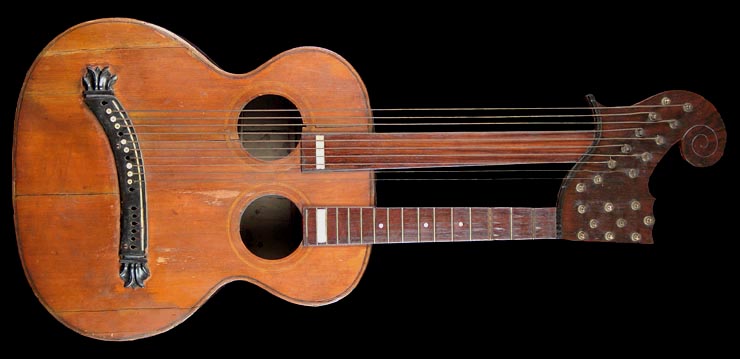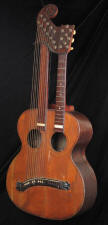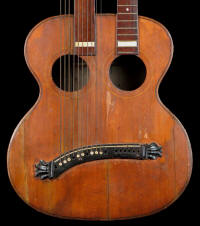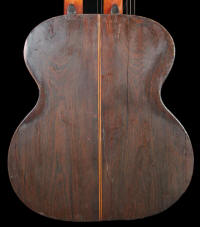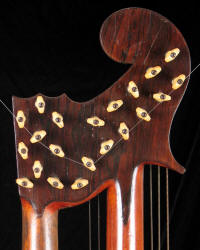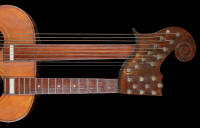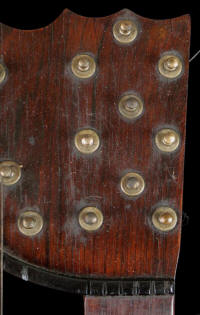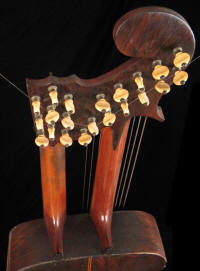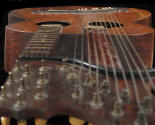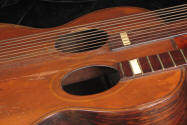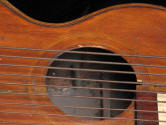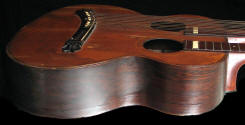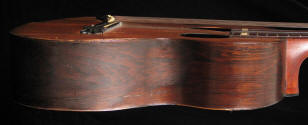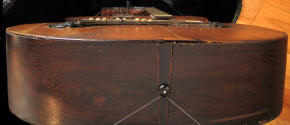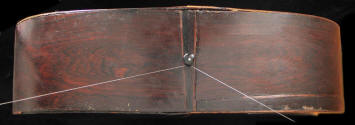
|
Harwood
Harp
Guitar, c.1900
|
|
Here is something you definitely don't see every day, and, frankly, may never see again... Harwood was a brand name of the Jenkins Company of Kansas, though the instruments seem to have been built - by persons or factory unknown - in New York. There are many fine Harwood parlor guitars of all grades known, plus a variety of mandolins - bowl back, flat back and mandolinettos - and a few harp guitars. All known harp guitars built - whether surviving, or known from vintage photographs or ads - are shown on the Harpguitars.net Harwood page. As seen, only three "double-holes" are currently known to survive: my incredible 12+6 specimen, this very similar 12+9 instrument, and a third with oval-shaped holes and 9 sub-basses. This is a tough instrument to evaluate - due to the condition - ergo the eBay listing. I would realistically value my subtly-restored instrument at $7500 minimum. In a room full of bizarre and spectacular instruments, it always gets noticed. It also plays great (discounting the awful friction tuners!), and sounds wonderful - not Dyer-wonderful, but pretty all the same. Mine is strung with full phosphor bronze, even though it is ladder-braced! The belly is dead flat. Perhaps partly due to the bridge plate which fully spans the top from horizontal brace-to-brace and from side-to-side. You can hear it on Volume 2 of my well-known Christmas Collection project. But enough about mine. I only include it to hint at what this one could become. It will unfortunately never reach the cosmetic condition of mine I am sure. But it could be resurrected into a wonderful wall hanger and/or a cool players instrument. How cool? Well, with a full 12 sub-basses, you could conceivable string and tune them to include both Stephen Bennett tuning and Hedges' "Because It's There" tuning - and still have one left over! Or you could get a full chromatic scale out of it, as was intended - to play classical, jazz or folk. The 9-string neck is a puzzle. It certainly looks like an add-on; the 6 bridge pin holes have (worn) double slots for the 3 high strings, and the 3 "extra" tuners look inserted into the already established 6 tuner placement on the headstock. Nevertheless, the period friction tuners are identical - if not done by the builder, they were certainly changed fairly early. Obviously, someone was interested in "half a 12-string"! Condition:
Bottom line? I've seen much worse restored (check out Kerry Char's resurrection of this Knutsen). LOTS of valuable potential here for a dedicated collector, player or luthier. As often the case, the reserve is my cost. Happy just for the chance to inspect and document it, then pass it on to someone similarly passionate. - Gregg Miner, the "harp guitar pope" |
|
|
Specifications:
|
